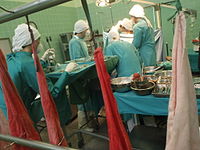
Photo from wikipedia
Elderly corneal tissues are usually not utilized based on the belief that these tissues would have poorer tissue quality in terms of lower endothelial count, arcus, scars or haze in… Click to show full abstract
Elderly corneal tissues are usually not utilized based on the belief that these tissues would have poorer tissue quality in terms of lower endothelial count, arcus, scars or haze in the stroma, and pseudophakic status of donors. However, some of these myths have been put to rest with the Cornea Donor Study (CDS), which suggested that the cumulative 5‐year graft survival was 86% in both below and above the age of 66. There was no significant difference between donor age and outcomes of keratoplasty.[1] The upper cutoff of donor age was 75 years; therefore, the outcomes of such donor corneas were unknown. Lack of knowledge regarding older donors aged >75 years has led to fears of possible graft failure due to which tissues are seldom used.[2] They have attempted to address a key area of corneal utilization among cornea donors aged >75 years. Their study is relevant in the context that 36.5% of all tissues were utilized, and the tissues that were phakic and had higher endothelial cell density had a higher chance of being utilized.
Journal Title: Indian Journal of Ophthalmology
Year Published: 2022
Link to full text (if available)
Share on Social Media: Sign Up to like & get
recommendations!